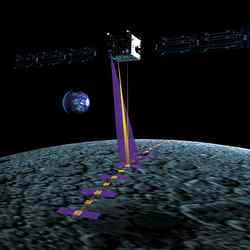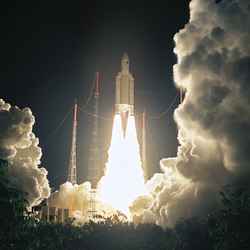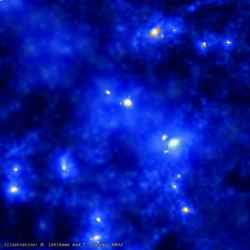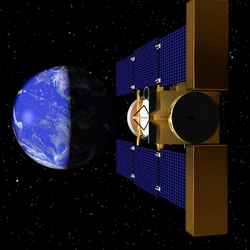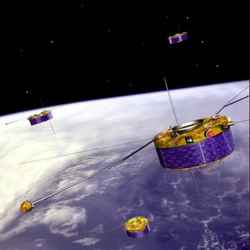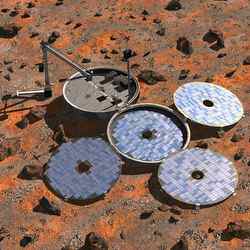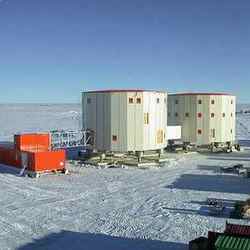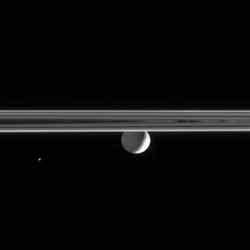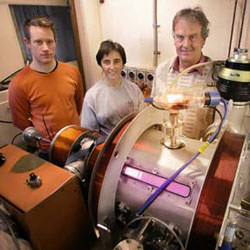
Dr. Charles and the ANU HDLT team. Image credit: ANU. Click to enlarge.
Listen to the interview: Plasma Thruster Prototype (5.5 MB)
Or subscribe to the Podcast: universetoday.com/audio.xml
Fraser: Can you give me some background on the thrusting technology you’ve invented?
Dr. Christine Charles: Okay, this thruster is called the HDLT, which stands for Helicon Double Layer Thruster, and it’s a new type of plasma thruster application into deep space travel. And the background is our expertise in plasma technologies, space plasma, plasma processing for treating surfaces and a variety of other applications.
Fraser: So, the favourite engine of the space exploration set these days is the ion engine, which has demonstrated quite good performance as a fuel efficient engine. How does the engine you’re working on relate to an ion engine? Can you give people some context?
Dr. Charles: Yes, there are some common aspects and some very different aspects. So, first the ion engine has been successfully developed for the past – I don’t know – 50 years or so. It’s quite well developed now. But the HD thruster has some interesting advantages. First, it doesn’t use any electrodes. So in the ion engine, you have a series of grids to accelerate the ion. So our thruster doesn’t have electrodes, we have a new type of acceleration mechanism that we call the Double Layer. This is why we call it HDLT: Helicon Double Layer Thruster. It has no electrodes, so that means it has a long lifetime because you don’t have electrode erosion. And a second, really important aspect is if you look at devices like ion engines, they emit ions. So you need to have an external source of electrons to neutralize these ions, and that’s generally done by having a second device on the side of the thruster which is called a hollow cathode device. In fact you have two devices on an ion engine. And often because they’re afraid that these hollow cathode devices might fail, they put two of them on to increase the lifetime. But in the HDLT, we actually emit a plasma, which in itself contains a supersonic ion beam. So we have the supersonic ion beam, which is the main source of thrust as it exits the thruster, but we also have the plasma which emits just enough electrons to neutralize the beam. So we don’t need this external device which is the neutralizer. That’s very good because it can provide safety, and simplicity – there’s no moving parts – so it makes the HDLT quite attractive for very deep space travel; long lifetime. And another advantage is that because we use a second concept called helicon plasma, it’s a very efficient way of transferring electricity into the charged particles in the plasma. That means we can get really dense plasmas with a lot of ions and we can scale up in power. So, we can probably go up to 100 kilowatts. This hasn’t been done yet here in a prototype, because our first prototype was just 1 kilowatt. But other experiments have suggested that with our type of plasma, we can really scale up in power, and to do that with an ion engine, basically the main thing is that when you go above a few kilowatts, you have to have a cluster of thrusters.
So I would say that it’s really early days for the HDLT, but the main advantages are increased lifetime, simplicity, scalability, and safety. And it’s also quite fuel efficient, which is very good.
Fraser: In terms of performance, ion engines can put out the thrust of the weight of a piece of paper, but they can do it for years and years and build up thrust. You’re saying that you could put out more thrust?
Dr. Charles: At the moment, ion engines are definitely the best in terms of thrust, for kilowatt, at the moment. And the HDLT prototype, which is just a concept and under 1 kilowatt, it doesn’t match the thrust. If you take the example of an ion engine, it typically has 100 milli newtons for one kilowatt. We’re talking probably 3-5 times less at the moment, but you have to see that we haven’t had 20 years of development. It’s early days, and we can certainly improve the technology.
Fraser: And then as I understand now, the European Space Agency has picked up the technology and is doing some in-house testing. And how’s that gone for them?
Dr. Charles: Okay, they had a few projects. The first thing is that we had a grant in Australia from a funding agency, and that was during 2004-2005. And we designed and manufactured the first HDLT prototype, which we brought to ESA last April, and which we tested for a month. We had limited funding so we couldn’t test it for more than a month. And this showed that all aspects of the thruster worked perfectly. But we tested all the powers that we could, and we had different gas pressures, etc. We didn’t have the diagnostics we needed to measure the thrust, so we didn’t know what the actual thrust was. The thrust that we have is what we can measure from the ion beam in Australia – it still has to be done. And it’s based on this very new concept of the double layer, which we had to convince people about. And ESA thought it was really interesting, so they had decided to have an independent study to validate the double layer effect. It’s the basic concept behind the thruster; the acceleration mechanism. So now we really have to see what this is about.
What is a double layer? You can just imagine, it’s like a river and suddenly the bed of the river falls down so that a waterfall is created. Then you have these ions which fall down this waterfall, and get accelerated and then get connected to the rocket with a large exhaust velocity. So the double layer is a potential drop in the plasma. What’s very interesting is that in the HDLT, we don’t have any electrodes; the plasma just decides to do this, by using a certain magnetic field, which is a magnetic bottle or nozzle. And that’s all. So it’s like having the waterfall without pumping the water through. So this is the basic concept.
So ESA had this independent study to validate the concept of the double layer. Have you seen the latest press release?
Fraser: Yes, I have.
Dr. Charles: So there was this latest study by Australia. We have the first prototype, and we have demonstrated some aspects; although, the thrust hasn’t been measured in a space simulation chamber yet. And ESA has also validated the concept behind the thruster, which is this double layer concept. So that’s where we’re at at the moment.
Fraser: So what kinds of missions do you think the HDLT thruster would be better for?
Dr. Charles: It has to be for really long term missions where you’re forced to go slowly, but for a long time. And it’s also has this nice safety aspect. It has the potential to be used for manned spaceflight. So it’s really for deep space missions, or going to Mars… things like that.
Fraser: I see. I guess one of its main advantages here is that it has less moving parts – parts that could break down.
Dr. Charles: And it can be scaled up in power, which is also important. NASA has made a simulation of what type of power you would need to send humans to Mars, and it’s in the megawatt range. So you will have to have the power. You’ll need to be able to scale up your thrusters as well. They need to be able to operate under large power to do the job. What NASA did is show that if you could have a proper plasma thruster, or plasma rocket, you could cut down the time to go to Mars because if you use plasma technology, you can use geodesic trajectories. If you use chemical propulsion, you’ll have more like a ballistic trajectory. So you can cut down on the time travel to Mars for example.
Fraser: So what are the next steps for your research?
Dr. Charles: Well, we’re doing various things in parallel. We’re still working very strongly on the double layer itself because this is a very nice kind of physics that has all kinds of other applications to the aurora, or solar wind acceleration, etc. We also have a new space simulation chamber here at the Australian National University. And we have mounted the prototype, which is back from ESA, into that space simulation chamber. And we’re going to start trying to measure the thrust balance and other ways, probably from January 2006. And there might be other news happening, I don’t know. We’ll see how it goes. We’ll definitely be putting a lot of effort into this subject. It’s very fascinating because many people are interested in the outcome.
HDLT Thruster Information from ANU
